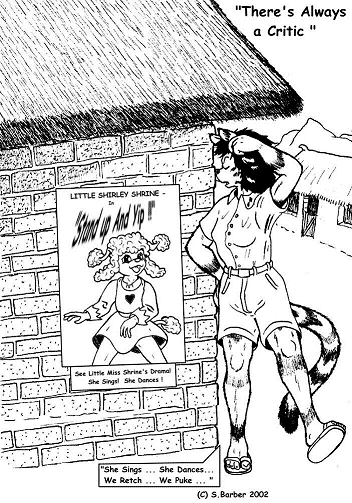|
Little Shirley Shrine – a
Filmography
(Condensed
from “Annoying Moppets of the Silver
Screen, Vol. I” by G. Zorski, 2 shillings paperback, 5/6 in
vomit-resistant covers from less discerning book shops everywhere.)
“A song, a dance and a merry
twinkle”, is how the film publicity described the typical Little
Miss Shrine film – to which this reviewer could add “a gasp, a retching
and a rapid retreat” on behalf of the audience. The puppy prodigy
tap-danced her way across the stages of the world from a tender age,
having been born into a show business family who were understandably
pleased to send her off to exotic filming destinations, well paid and
(presumably) heavily insured.
Her first outing was in 1933, in “Dance for your life!” a low-budget
film comedy about the infamous Paraguayan dictator Lopez, in which she
played the daughter of the exiled opposition leader. Her big singing
number, a cheerful cover of “I ain’t
got nobody” as she tap-dances through a depopulated and
skeleton-littered countryside, caused a sensation wherever it was
played. The sensation this reviewer experienced was centred in the pit
of the stomach, rather reminiscent of crossing the stormy English
Channel on a small boat after a large fried breakfast.
Possibly fearful of facing the crowds back home, the
producers scheduled more overseas filming in the following years,
starting with the slapdash romantic farce “The Little Commissar” set on
location in what the film claims is an open-air holiday camp in the
hills behind Vladivostok. Little Shirley’s soft-shoe shuffle sequence
across the roof of the lead refinery is said to be one of the Russian
leader Ioseph Starling’s all-time film favourites.
“Stand up and Yip!”
of Spring 1934 has the curly-topped menace playing an orphan whose
orphanage is relocated from the Dust Bowl to the backwoods of the
Appalachians, which presumably counted as suitably abroad to the
Hollywood producers. Her tender ballad “Animal Snackers” where she struts
heel-and-toe through an all-dancing village of cannibal hillbillies has
never been equalled, or even attempted since. (It may be a coincidence
that the state the film was set in, declared cannibalism a misdemeanour
rather than a felony a month after the first screening.)
“The Good Ship
Sherbet Dip” of Spring 1935 was set further afield in the
Spontoon Islands, which provided a spectacular scenic backdrop to the
heart-warming tale of the chieftain’s daughter who has to choose which
of her classmates must be sacrificed to the Volcano God. A surprisingly
catchy tune, “You have to be fair –
don’t think I don’t care” finishes off the film where she must
make her agonising decision – she teaches the grown-ups a lesson by
choosing to sacrifice ALL her classmates.
“Baby, Take A Dive”
followed not three months later, taking advantage of the famously lax
Cuban employment laws to shoot a film set in the brutal underworld of
bare-knuckle playground prize-fighting. Little Shirley plays the leader
of an all-singing ten-girl boxing team, who use their dancing skills
and a surprisingly precocious knowledge of “low blows” to weave and
shuffle their way to victory.
A string of very similar films followed throughout
the 1930’s, with exotic filming destinations substituting for any sort
of plot. Miss Shrine’s insistence on always having the best available
dance instructors and costumes often forced the producers to save money
elsewhere – in “Fairy Tails”
of 1936 there was no actual script-writer, and the extras of “Shrine on Harvest Moon” were paid
in Little Shirley’s own trademarked range of sweets, dolls and suchlike.
By the 1940’s, Miss Shrine’s trademarked style was
out of fashion, and her star faded. The wartime film “Boogie-woogie Bongo Belle” achieved
fame, though mainly controversy – it was supposedly filmed to boost
troop morale, but the Chief of Staff later admitted it “had been worth
three elite divisions to the enemy.”
That same year saw her name appearing one of the
periodical Hollywood scandals, which put an end to the unbroken string
of productions that had lasted a decade. To this day no two people have
agreed what the scandal involved, but all agree that even in Hollywood
circles, it was so extreme that nobody ever told anyone a single detail
about it.
The final film to which Miss Shrine put her name,
was 1955’s lacklustre “I was a
Teenage Warmonger” which has, to date, been the last of its line
the world of film has endured. But like influenza, we can never say it
has really gone away…
(Edited by Mr. Simon Leo Barber
from his clipping colletion)
|
